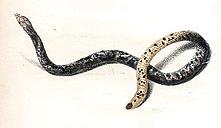The Uropeltidae, the shieldtail or shield-tailed snakes, are a family of primitive, nonvenomous, burrowing snakes endemic to peninsular India and Sri Lanka. The name is derived from the Greek words ura ("tail") and pelte ("shield"), indicating the presence of the large keratinous shield at the tip of the tail. Seven or eight genera are recognized, depending on whether Teretrurus rhodogaster is treated in its own genus or as part of Brachyophidium. The family comprises over 50 species. These snakes are not well known in terms of their diversity, biology, and natural history.
Tropidolaemus huttoni is a little-known species of pit viper, a venomous snake in the subfamily Crotalinae of the family Viperidae. The species is endemic to the southern Western Ghats of India. There are no subspecies that are currently recognized. Little is known about this species, as this species is known only from two young individuals, based on which it was first described in 1949. Despite long-term and targeted herpetological surveys in the particular hill range (Meghamalai), it has never been re-sighted there or elsewhere since then.
Trimeresurus strigatus, commonly known as the horseshoe pitviper, is a venomous pitviper endemic to the Western Ghats. No subspecies are currently recognized.

Trimeresurus macrolepis, commonly known as the large-scaled pitviper is a venomous pitviper species endemic to the Southern Western Ghats of South India. No subspecies are currently recognized.

Trimeresurus malabaricus, commonly known as Malabar pit viper, Malabar rock pit viper, or rock viper, is a venomous pit viper species endemic to the Western Ghats of southwestern India. No subspecies are currently recognized.

Melanophidium bilineatum, commonly known as the two-lined black shieldtail or iridescent shieldtail, is a species of snake endemic to India. This species was known from only three specimens and very little information is available of it in the wild.
The purple-red earth snake is a species of nonvenomous shield tail snake, endemic to southern India. No subspecies are currently recognized.
Uropeltis ceylanica is a nonvenomous shield tail snake species endemic to the Western Ghats of South India. No subspecies are currently recognized; but the presence of several synonyms, many recently resurrected, calls for further taxonomic studies of this species complex.
Uropeltis macrorhyncha is a nonvenomous shield tail snake species endemic to India. No subspecies are currently recognized.
Common names: spotted earth snake.
Uropeltis maculata is a nonvenomous shield tail snake species endemic to southern India. No subspecies are currently recognized.
Uropeltis nitida is a species of nonvenomous shield tail snake. It is endemic to southern India. No subspecies are currently recognized.
Uropeltis ocellata is a non-venomous shield tail snake species found in southern India.
Uropeltis rubrolineata is a nonvenomous shield tail snake species endemic to southern India. No subspecies are currently recognized.

Uropeltis rubromaculata is a nonvenomous shield tail snake species endemic to southern India. No subspecies are currently recognized.
Uropeltis is a genus of nonvenomous shield tail snakes endemic to peninsular India. As of 2017, 23 species are recognized.

Plectrurus is a genus of nonvenomous shield tail snakes endemic to the Western Ghats of South India. Currently, four species are recognized. They inhabit high elevation montane Shola forests and are usually found under fallen logs and rocks. Some species are rare while some are quite common in their range.

Rhinophis is a genus of nonvenomous shield tail snakes found in Sri Lanka and South India. Currently, 19 species are recognized in this genus. Of the 19 species, 15 are endemic to Sri Lanka, while 4 are endemic to South India.
Teretrurus rhodogaster is a species of nonvenomous shield tail snake, endemic to the Western Ghats of India. It is known as Wall's shield tail snake, Palni Mountain burrowing snake, or red-bellied shieldtail.
Platyplectrurus is a genus of nonvenomous shield tail snakes endemic to the Western Ghats of India. Currently, 2 species are recognized.






